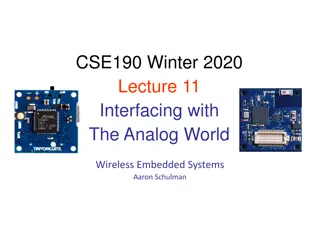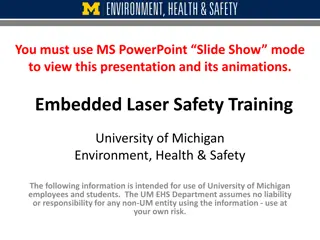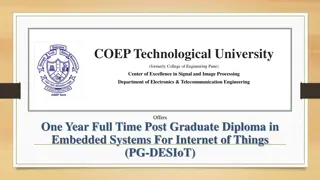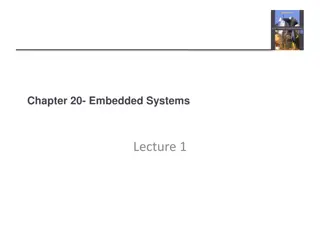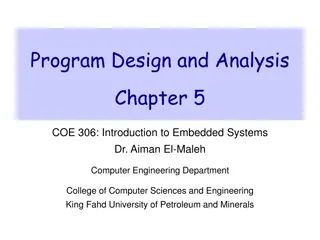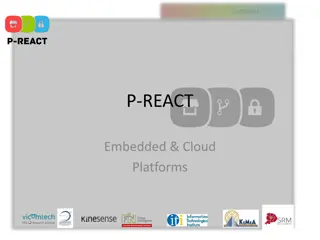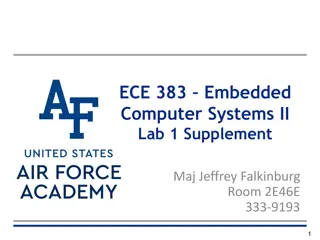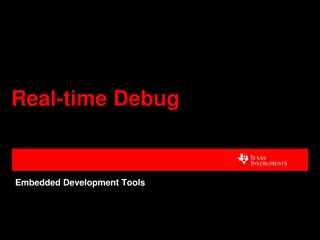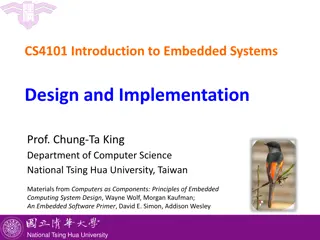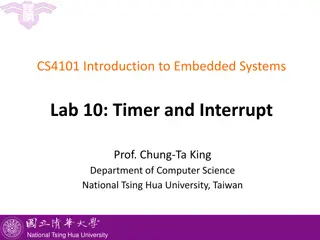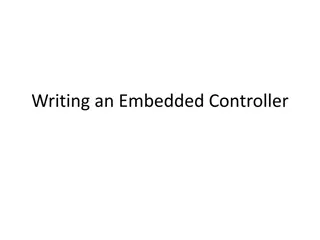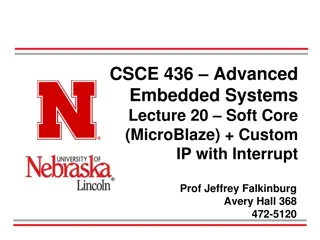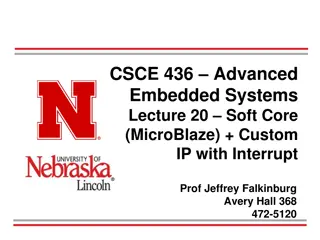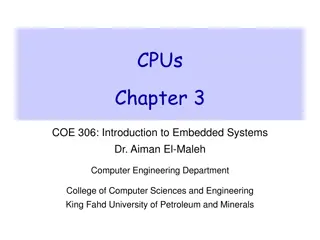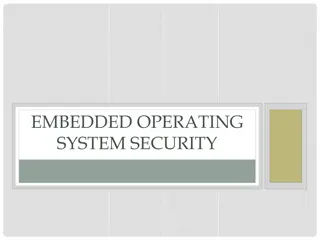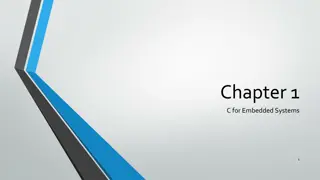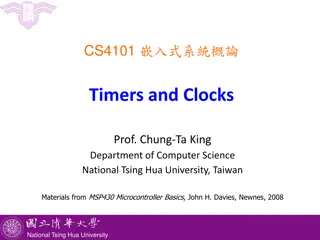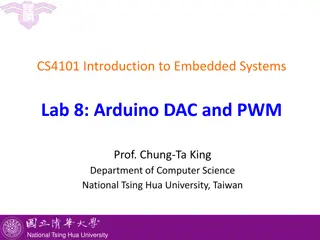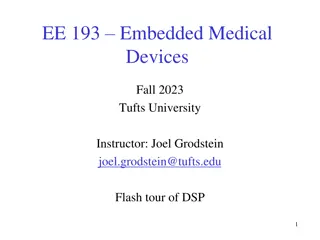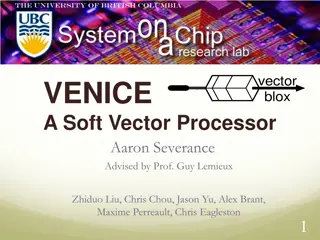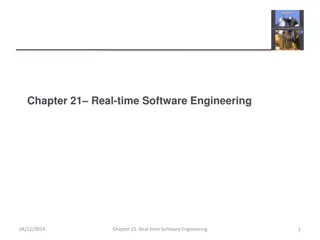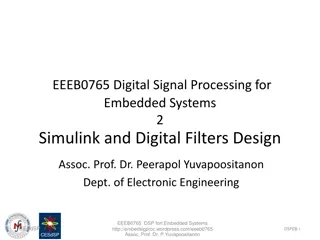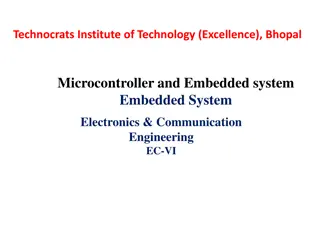Embedded Systems Design Process in the Embedded systems
Embedded systems are all around us, from the tiny microcontrollers in our household appliances to the sophisticated control systems in cars and aeroplanes. But how are these systems designed? Let's delve into the basics of the embedded systems design process in simple terms that anyone can understan
2 views • 9 slides
Understanding Embedded Clauses in Writing
Explore the use of embedded clauses in writing through examples and practice exercises. Learn to identify main and subordinate clauses, conjunctions, and create sentences with fronted adverbials. Enhance your writing skills by understanding the structure and function of embedded clauses.
0 views • 12 slides
Interfacing with Analog Signals in Embedded Systems
Exploring the conversion of analog signals from the physical world into electrical signals using transducers in embedded systems. Learn about going from analog to digital representation, choosing sample rates, the Shannon-Nyquist sampling theorem, importance of anti-aliasing filters, and the necessi
0 views • 18 slides
Understanding The Stack in Embedded Systems Design
The stack plays a crucial role in embedded systems design by providing a last-in, first-out storage structure for dynamic memory allocation. In this chapter, Dr. Brock J. Lameres explores the concept of the stack, its physical implementation in microcontrollers like the MSP430FR2355, and the operati
2 views • 27 slides
Embedded Laser Safety Training at University of Michigan
This presentation focuses on embedded laser safety training at the University of Michigan, covering topics such as laser hazards, responsibilities of lab directors, safe usage of equipment containing lasers, and what to do in case of injuries. It emphasizes the importance of identifying risks, avoid
0 views • 27 slides
Introduction to Embedded Systems Design
Embedded Systems Design, Chapter 1 provides an insightful overview of embedded systems, distinguishing them from general-purpose computers. The chapter delves into the characteristics of embedded systems, their design considerations, and the various types of embedded computers such as general-purpos
1 views • 7 slides
COEP Technological University Offers Post Graduate Diploma in Embedded Systems for Internet of Things
COEP Technological University, formerly known as College of Engineering Pune, is offering a one-year full-time Post Graduate Diploma in Embedded Systems for Internet of Things (PG-DESIoT). This program addresses the increasing demand for expertise in embedded systems and IoT applications. It include
0 views • 16 slides
Understanding Different Types of Operating Systems
An operating system is the crucial program that manages a computer's resources and acts as an interface between the user and the machine. Various types of operating systems exist, including real-time, multi-user vs. single-user, multi-tasking vs. single-tasking, distributed, and embedded systems. Re
1 views • 11 slides
Embedded Research Conference Workgroup B: Management Decisions Support
Workgroup B at the Embedded Research Conference focuses on providing research support for management decisions. The participants aim to identify and prioritize operational questions that could benefit from embedded research, work productively within the existing QI ecosystem, and create an inventory
0 views • 14 slides
Understanding Embedded Systems: A Comprehensive Overview
Embedded systems play a crucial role in controlling various devices and machines. They require real-time responsiveness for correct functioning, making timing analysis and architectural patterns essential. Embedded system design involves considering hardware and software interactions, system charact
1 views • 46 slides
Efficient Dynamic Memory Management for Embedded Multicore Systems
This content delves into the challenges of dynamic memory management in embedded multicore systems, emphasizing the importance of transaction-friendly approaches. It covers parallel data structures, the role of operating systems/libraries, and principles of memory allocation. Through illustrations a
0 views • 24 slides
Introduction to Embedded Systems and Software Components
Embedded systems play a crucial role in various applications, with components like state machines, circular buffers, and queues being essential. State machines help in maintaining system behavior, while circular buffers are useful in digital signal processing. The use of queues aids in managing task
0 views • 78 slides
Cutting-Edge Embedded and Cloud Platforms Unveiled on 13th September 2024
Unveiling the futuristic P-REACT Embedded System on 13/09/2024, boasting easy installation, real-time reconfiguration, and standalone operation capabilities. Dive into the architecture and modules of this system, including the Embedded System Manager, Sensors Manager, Clip Generator, and more. Explo
0 views • 11 slides
Exploring Embedded Librarianship in Academic Health Sciences Programs
This content delves into the concept of embedded librarianship in academic health sciences programs, showcasing cases and insights from the frontline. It highlights the various roles and responsibilities of embedded librarians, including providing research assistance, creating tutorials, engaging wi
0 views • 26 slides
Embedded Computer Systems Lab 1: VGA Module Overview
This document provides an overview of Lab 1 for Embedded Computer Systems II, focusing on the VGA module and its functionalities. It includes details about the VGA module entity, its ports, clock signals, trigger voltage and time representation, channel signals, color intensities, row and column val
0 views • 18 slides
Understanding Real-time Debug Techniques for Embedded Development
Real-time debugging in embedded systems involves different modes like stop mode and real-time mode, each offering unique capabilities for accessing memory, registers, and handling interrupts. This technique allows developers to examine and modify memory contents while the processor is running, enabl
0 views • 32 slides
Embedded Systems Design: An Introduction to Developing Smart Devices
Delve into the world of embedded systems design with a focus on creating smart devices that enhance everyday objects. Understand the importance of embedded systems, explore typical design flows, and learn how to define requirements for developing efficient and functional products. Start your journey
0 views • 19 slides
Adapting Linear Hashing for Flash Memory Constrained Embedded Devices
This research explores the adaptation of linear hashing for improved data handling on flash memory-constrained embedded devices. Motivated by the increasing data collection by IoT devices, the study focuses on implementing database structures like a linear hash table for efficient data processing. T
0 views • 67 slides
Embedded Systems Lab 10: Timer and Interrupt
This lab focuses on learning about timers and interrupts in embedded systems using MQX at National Tsing Hua University. It covers creating timer components, starting timers, and provides examples on simulating the control of an LED using timers. The content includes code snippets and explanations r
0 views • 15 slides
Embedded Controller Programming Basics
Learn the fundamentals of writing an embedded controller program, including initialization, main loops, and handling input tasks. Explore a simple program that prints messages periodically and processes key inputs effectively. Advance to a slightly more complex version with menu functionality trigge
0 views • 11 slides
Understanding Timers and Time Tracking in Embedded Systems
Explore the importance of timers in embedded systems for tracking time, managing interrupts, and ensuring accurate timekeeping. Learn about different peripherals used, such as real-time clocks and processor timers, to handle tasks like updating UI elements, triggering alarms, and measuring intervals
0 views • 24 slides
Understanding Interrupts and MicroBlaze in Advanced Embedded Systems
Dive into the world of interrupts in embedded systems with a focus on MicroBlaze architecture. Learn how interrupts enable multitasking, the process of handling interrupts, and generating interrupts in MicroBlaze. Explore custom IP integration and gain insights into interrupt-driven programming. Dis
0 views • 32 slides
Understanding Interrupts in Embedded Systems using MicroBlaze
Dive into the world of interrupts in embedded systems with a focus on using the MicroBlaze soft core processor and custom IP to handle interrupts efficiently. Learn about the significance of interrupt service routines, interrupt handling process, and how to generate interrupts in MicroBlaze for seam
0 views • 30 slides
Embedded Systems: Introduction to Input and Output Devices
This material explores the essential concepts related to input and output (I/O) devices in embedded systems. It covers examples of I/O devices, such as keyboards, mice, and disk drives, along with the digital interface between these devices and the CPU. Specific focus is given to the 8251 UART as an
0 views • 55 slides
Energy-Efficient Query Processing on Embedded CPU-GPU Architectures
This study explores the energy efficiency of query processing on embedded CPU-GPU architectures, focusing on the utilization of embedded GPUs and the potential for co-processing with CPUs. The research evaluates the performance and power consumption of different processing approaches, considering th
0 views • 22 slides
Understanding Embedded Operating System Security
Embedded operating systems are designed for special purposes with limited resources and small sizes, found in various devices like ATMs, smartphones, cars, and more. Common operating systems include VxWorks, Windows, QNX, and SCADA, with different applications and requirements. Windows CE stands out
0 views • 21 slides
Understanding Data Types and Operations in C Programming for Embedded Systems
Explore the importance of selecting appropriate data types and bitwise operations in C programming for embedded systems. Learn about the sizes of data types, performance considerations, ANSI C integer data types and their ranges, handling overflow issues, and coercion in programming. Enhance your kn
0 views • 17 slides
Exploring Values-Embedded Action Research in Education
Dive into a comprehensive exploration of values-embedded action research in education, focusing on how personal values influence teaching practices and contribute to broader societal impacts. Discover the importance of understanding core values, creating valid accounts of living-theory research, and
0 views • 11 slides
Embedded Systems: Timers, Clocks, and Real-Time Control
Explore the role of timers and clocks in embedded systems, covering topics such as real-time monitoring, time-based control, and challenges with software delay loops. Learn about using hardware counters for time references and integrating timers as I/O devices in clock systems.
0 views • 48 slides
Understanding Embedded Systems and Cyber-Physical Systems
Embedded systems are specialized computer systems embedded within larger systems, such as control systems and car controllers. This lecture covers real-time aspects, applications of Cyber-Physical Systems (CPS), and examples like the Boeing 777/Airbus A380 cockpit. It discusses the design process of
0 views • 22 slides
Advances in Testing C-Planarity of Embedded Flat Clustered Graphs
This research work explores the complexity and special cases of C-planarity testing in embedded flat clustered graphs. It discusses the challenges, known polynomial subcases, and the concept of saturators in the context of flat embedded clustered graphs.
0 views • 21 slides
Database Benchmarking: Embedded Databases Comparison
This project involves benchmarking lightweight embedded databases like SQLite, BerkeleyDB, and others. Students will evaluate and compare these databases using specific workloads to analyze their performance. The outcomes include a detailed report on each system's strengths and weaknesses. Required
0 views • 19 slides
Introduction to Arduino DAC and PWM in Embedded Systems Lab
Explore the practical application of Arduino's digital-to-analog converter (DAC) and pulse width modulation (PWM) techniques through projects involving RGB LED modules, analog joysticks, and stepper motors. Learn to control RGB LED colors, read analog joystick input values, and operate stepper motor
0 views • 10 slides
Introduction to Embedded Systems Overview
Embedded systems are ubiquitous computing systems found in electronic devices beyond traditional computers. They encompass a vast variety of units, far outnumbering desktop computers, with significant presence in households, automobiles, and various other applications. This introduction provides ins
0 views • 17 slides
Introduction to Digital Signal Processing for Embedded Medical Devices
Join Joel Grodstein in the Fall 2023 session of EE.193 at Tufts University for a flash tour of DSP. Explore why DSP is essential for embedded medical devices, learn about noise sources, and discover how filters can enhance signal quality. Engage in in-class exercises to practice noise frequency meas
0 views • 27 slides
Exploring Overlay Architecture for Efficient Embedded Processing
The research delves into the implementation of overlay architecture for embedded processing, aiming to achieve optimal performance with minimal FPGA resource usage. It discusses motivations for utilizing FPGAs in embedded systems, the challenges of balancing performance and resource utilization, and
0 views • 24 slides
Understanding Real-time Software Engineering for Embedded Systems
Embedded systems play a crucial role in controlling various machines and processes. Real-time software engineering focuses on designing systems that respond instantly to events, ensuring correctness and timeliness. Characteristics like continuous operation, unpredictable environment interactions, an
0 views • 59 slides
Understanding Interconnection Networks in Embedded Computer Architecture
Explore the intricacies of interconnection networks in embedded computer architecture, covering topics such as connecting multiple processors, topologies, routing, deadlock, switching, and performance considerations. Learn about parallel computer systems, cache interconnections, network-on-chip, sha
0 views • 43 slides
Digital Signal Processing for Embedded Systems: Simulink and Digital Filters Design
Explore the world of Digital Signal Processing for Embedded Systems with an emphasis on Simulink and Digital Filters design. Discover tools, examples of Simulink models, basics of noise cancellation, and applications of active noise cancellation headphones. Dive into the realm of Embedded Systems th
0 views • 38 slides
Understanding Embedded Systems in Electronics & Communication Engineering
Embedded systems are a crucial part of electronics and communication engineering, combining software and hardware to perform specific functions within a larger system. They offer real-time operation, single functionality, high reliability, and limited user interface. Components like sensors, A-D con
0 views • 25 slides


